Read Time: 6 Minutes Subscribe & Share
Intro To A Master Gardener
Two years ago, KD featured a post about guerilla gardening both in the UK and in our own backyard in Northern Virginia. Kathryn Kellam, one of the Master Gardeners at Master Gardeners Of Northern Virginia proved to be a great source of information. I learned about garden centers for native plants for our area and also how to resuscitate the two sad tree wells around my building. I am not a gardener, I simply buy plants, but I get a lot of help from Jody McGowan, a dedicated organic gardener and urban landscaper. My total contribution has been the aforementioned adopted tree wells and a creeping series of containers by my front entrance and side alley of my building. Kathryn Kellam, on the other hand, has two gardens surrounding her house — both filled with native and environmentally helpful species. She now gives tours to a great number of interested people starved for information on how to improve their own properties. She wrote me:
Information people receive from landscape companies, mosquito control companies, and others can be incorrect, misleading, or unhealthy. Think tree-topping instead of proper pruning; unnecessary or over-fertilization of lawns, creating toxic runoff into our waterways; and noxious sprays to kill mosquitos (and every other insect in range) instead of education on preventive measures.
In her role as an Extension Master Gardener she serves at plant clinics at farmers’ markets in our area. (You can usually talk to her at the Del Ray Farmers’ Market). She and Master Gardener Susan Wilhelm grew over 20 unusual basils from seed and co-produced a helpful film/lecture on this herb, which has around 150 varieties! Their discoveries of lesser known basils and advice on growing them both indoors and out prompted me to replant a few in better suited conditions, and I am already reaping some benefits in my summer dishes.
Beyond Pesto
We are not talking Genoese, Thai, or even the frilly and floppy lettuce basil, but rather cultivars like Lemon Basil, Chinese Sweet Basil, Persian Basil or African Blue Basil. Kathryn suggested them as a few of her favorite discoveries to search out and grow. Not surprisingly, basils are a member of the mint family and, contrary to other Mediterreanean herbs such as oregano and rosemary, they actually prefer not only hot sun (forget surviving even a moderate cold snap) but also the miserable humidity that we have here. Kathryn said that the mesclun and mixed green salad bags that we now rely on are so boring that the addition of a few of these different basils will make them much tastier. I found some of these basils at Blue Ridge Botanicals at the Old town Market on Saturdays and also at the Sharkawi Farm stand at the McCutcheon Farmers Market on Sherwood Hall Lane on Wednesdays. Both purveyors are quite knowledgeable and helpful.
 Lemon Basil, used extensively in Laotian cuisine, is believed to be a hybrid of African Basil and Sweet Basil. As an annual that’s been around for thousands of years, it’s a common addition to Southeast Asian, Arabic and North African dishes. Records show that it arrived to North American gardens via the Massachusetts Bay Colony in the early part of the 17th century. Its lemon and slight anise flavor shows best when used raw, added just before serving Even the flowers, which are white, give off a light lemon aroma and can be used as an edible garnish. It is highly perishable once cut, and should be used within a day or two at most. Make a light vinaigrette with lemon basil (no mustard) and dress a mozzarella salad or grilled zucchini slices On the health side, lemon basil is a prodigious source of Beta-carotene, which, when converted to Vitamin A, protects vision loss.
Lemon Basil, used extensively in Laotian cuisine, is believed to be a hybrid of African Basil and Sweet Basil. As an annual that’s been around for thousands of years, it’s a common addition to Southeast Asian, Arabic and North African dishes. Records show that it arrived to North American gardens via the Massachusetts Bay Colony in the early part of the 17th century. Its lemon and slight anise flavor shows best when used raw, added just before serving Even the flowers, which are white, give off a light lemon aroma and can be used as an edible garnish. It is highly perishable once cut, and should be used within a day or two at most. Make a light vinaigrette with lemon basil (no mustard) and dress a mozzarella salad or grilled zucchini slices On the health side, lemon basil is a prodigious source of Beta-carotene, which, when converted to Vitamin A, protects vision loss.
Not as much is known about the origins of Chinese Sweet Basil, but this variety has a very pungent and enticing aroma. The leaves have a lemon-orange flavor. This variety is difficult to find in the US. Unlike some of its more commonly grown cousins, the stems can be used along with the leaves in salads. It grows like wildfire and can produce tender leaves all summer long and, of course, is perfect for Northern Virginia’s humid and hot summers.
find in the US. Unlike some of its more commonly grown cousins, the stems can be used along with the leaves in salads. It grows like wildfire and can produce tender leaves all summer long and, of course, is perfect for Northern Virginia’s humid and hot summers.
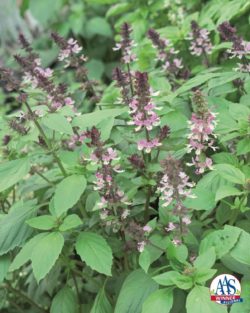 Persian Basil, whose origins are Middle Eastern, was at the top of Kathryn’s list of favorite discoveries. Its leaves are large and the plants can become almost ornamental bushes, even though it is an annual. It develops flowers later in the fall, so you can benefit from tender leaves longer than you can with Genoese basils. It, too, has a telltale citrus-clove aroma and flavor. Its fall blooms make for nice farewell-to-summer floral arrangements.
Persian Basil, whose origins are Middle Eastern, was at the top of Kathryn’s list of favorite discoveries. Its leaves are large and the plants can become almost ornamental bushes, even though it is an annual. It develops flowers later in the fall, so you can benefit from tender leaves longer than you can with Genoese basils. It, too, has a telltale citrus-clove aroma and flavor. Its fall blooms make for nice farewell-to-summer floral arrangements.
African Blue Basil can be a perennial in areas that do not have very cold winters. It was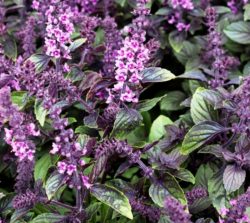 discovered in the late 20th century at a nursery in Ohio, as a cross between purple opal and African camphor basils, and is sterile so propagation has to be done by cuttings. Its flavor is similar to lemon thyme, with a bit more spice. It releases a heady oil that is used in insect repellents and is beloved as a flavoring for specialty cocktails by mixologists.
discovered in the late 20th century at a nursery in Ohio, as a cross between purple opal and African camphor basils, and is sterile so propagation has to be done by cuttings. Its flavor is similar to lemon thyme, with a bit more spice. It releases a heady oil that is used in insect repellents and is beloved as a flavoring for specialty cocktails by mixologists.
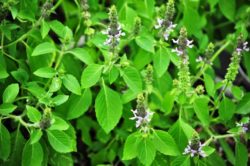 Holy Basil or Tulsi has some interesting attributes and confusions as a medicinal and sacred plant in India — particularly for Ayurveda, a traditional medicine system. It is used only for water infusions in Hindu ceremonies and for topical applications Some holistic health advocates have prescribed it as a treatment for high cholesterol, anxiety, diabetes and stress, even though there exists no scientific evidence to support its use. Another Basil from Germany, which we call Spice Basil and has a peppery taste, carries the name of Kapoor Tulsi (a misnomer from the 20th century which has never been correcte) . This one has an an intriguing taste and is often used in stir-fried dishes. It is pictured at the left.
Holy Basil or Tulsi has some interesting attributes and confusions as a medicinal and sacred plant in India — particularly for Ayurveda, a traditional medicine system. It is used only for water infusions in Hindu ceremonies and for topical applications Some holistic health advocates have prescribed it as a treatment for high cholesterol, anxiety, diabetes and stress, even though there exists no scientific evidence to support its use. Another Basil from Germany, which we call Spice Basil and has a peppery taste, carries the name of Kapoor Tulsi (a misnomer from the 20th century which has never been correcte) . This one has an an intriguing taste and is often used in stir-fried dishes. It is pictured at the left.
Living dangerously in my new found basil world, I found Cardinal Basil, and was advised to put it in a big pot all by itself.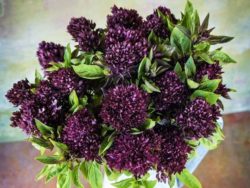 With little encouragement, it grows somewhat like a bush, with what was described as “pagoda like flowers” on the Specialty Produce website. Interestingly, the Israeli company Genesis Seeds developed this particular basil. It is indeed branching out to the perimeters of its pot, and I have used it in some of my Italian and French dishes, where it gives a slightly spicier edge than Genoese basils. I am torn about pinching back the flowers, but will discipline myself as the minute the pagodas come out, the leaves lose that enticing flavor.
With little encouragement, it grows somewhat like a bush, with what was described as “pagoda like flowers” on the Specialty Produce website. Interestingly, the Israeli company Genesis Seeds developed this particular basil. It is indeed branching out to the perimeters of its pot, and I have used it in some of my Italian and French dishes, where it gives a slightly spicier edge than Genoese basils. I am torn about pinching back the flowers, but will discipline myself as the minute the pagodas come out, the leaves lose that enticing flavor.

Kitchen Detail shares under the radar recipes, explores the art of cooking, the stories behind food, and the tools that bring it all together, while uncovering the social, political, and environmental truths that shape our culinary world.
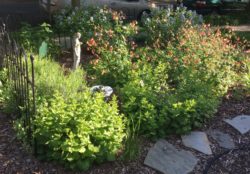





A lovely article on a favorite herb! Thank you.
I have now planted six varieties of basil (not from seed) a dad Kathryn said, I am just enjoying them in salads and in sauces.